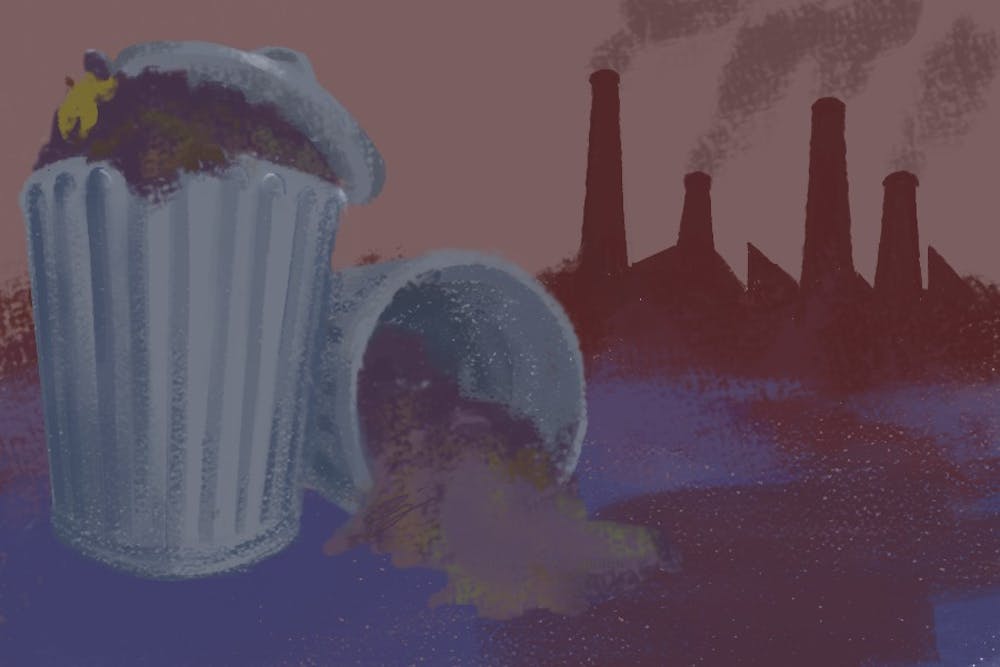Philadelphia has a trash problem—residents are familiar with the stacks of garbage overflowing from cans; they know all too well the sight of ripped trash bags littering front lawns across the city. The Philadelphia Streets Department, which manages waste collection, is notorious for its sporadic pickup schedule, leaving behind serious consequences for Philadelphians. In addition to negative physical health effects, studies on the mental health impact of living in an area with excessive waste have found that litter corresponds with higher rates of stress and discourages feelings of safety and security. The city has blamed everything from the weather, to staff shortages, to increased trash during the pandemic for their dysfunctional garbage pickup system. But these excuses have left Philadelphians frustrated as the trash continues to pile up in their neighborhoods.
Although the city has received wide–spread criticism towards its unpredictable garbage collection, where the trash goes after it’s picked up is rarely acknowledged at all.
Philadelphians produce nearly 1.4 million tons of trash each year. About 55 percent of this waste is dumped in a landfill, while the other 45 percent is trucked to one of two incinerator facilities. Philadelphia has contracts with Waste Management—the world’s largest waste corporation, which operates incinerators in Northeast Philadelphia—and Covanta—the country’s largest trash incinerator company, which operates an incinerator southwest of Philadelphia in a city called Chester.
Chester is a small city of 34,000 people, with two-thirds of residents being Black or African American. Nearly 32% of Chester’s population also currently lives below the poverty line. Despite its small size, Chester is home to a multitude of sites established by waste corporations: a sludge incinerator, a Delaware County sewage treatment facility, chemical manufacturing plants, and America’s biggest trash incinerator.
The presence of several high–pollution industrial facilities in Chester is no coincidence. Companies like Covanta prefer to be located in low–income, predominantly—minority neighborhoods because they believe these communities lack the influence to oppose them. In turn, cities like Philadelphia, which employs Covanta, view Chester itself as a dumping ground, and the residents of Chester as expendable.
Despite the concentration of polluting industries in Chester, the City of Philadelphia still chooses to burn their garbage there—overtly perpetuating environmental racism in their waste disposal contracts with these companies. Philadelphia city leaders are well aware of Covanta’s long legacy of polluting activities, but following Mayor Jim Kenney’s recommendations, the City Council recently approved a renewal of its contract with the incinerator company in 2019. These contracts can last 4 to 7 years, with options for continuous renewal. Covanta’s incinerator is currently the largest industrial polluter in Delaware County—consistently ranking amongst the highest emitters for pollutants like sulfur dioxide, and often lacking the most basic pollution control measures.
The excessive pollution in Chester and the lack of pollution controls is causing a public health crisis for its residents. In 1995, an EPA study found that 60% of Chester children tested for dangerous levels of lead in their blood. Heavy metals like lead can cause developmental disabilities in children and impair brain function. Both cancer and respiratory diseases occur at excessively high rates in Chester compared to national or state levels, and nearly 38% of Chester children have asthma. Among almost any health metric linked to pollution, Chester has some of the worst health outcomes in the country.
But like countless other cases of environmental racism, the communities disproportionately affected by the pollution are not the same communities that are responsible for producing it. Only about 2% of the trash burned in Chester is produced within Chester itself. Most of the trash is trucked from Delaware County, Philadelphia, Maryland, and even New York City. Chester is used as a public dumping ground for these cities and townships to conveniently dispose of their waste with little regard for the residents living there.
But the residents of Chester are fighting back. At every step of the way, organizers like Zulene Mayfield have been protesting, suing, and physically obstructing Covanta and other industrial polluters in the city. Mayfield has been living in Chester for decades, but she began to notice problems when a foul smell permeated through the city and garbage trucks made an endless procession through the streets.
“Living among all that garbage, made me feel like garbage,” Mayfield says. The pollution had gotten so bad that children could not go outside to play. She remembers older residents with health issues being confined to their homes to avoid the noxious fumes.
Mayfield is a founder of Chester Residents Concerned for Quality Living (CRCQL). The group consists of Chester residents, scientists, students, and environmental activists looking to shut down the Covanta incinerator and prevent new polluters from coming to the city. This has proven difficult with an endless barrage of polluters attempting to relocate to Chester, but Mayfield and CRCQL refuse to give in to the industrial corporations laying siege to their community.
“We didn’t choose to have this here, they chose us. So we fight,” she says. Mayfield and CRCQL have had key successes in their organizing efforts, including when a soil remediation plant and a medical waste incinerator were denied permits to operate in Chester following pressure from CRCQL, and being the first group to file an environmental racism lawsuit in the United States.
Climate change is the defining issue of our lifetimes. In addressing a problem of this scale, communities like Chester offer an important example of collective resistance to preserve residents' health and wellbeing in the face of great opposition. Grassroots organizing and environmental justice campaigns ultimately strike at the heart of what the environmentalism movement is about: people coming together to protect their communities. We must be cautious when deciding who to do business with, as in the case of Philadelphia and Covanta, and mindful about supporting and amplifying the work of community organizers who lead the way.

